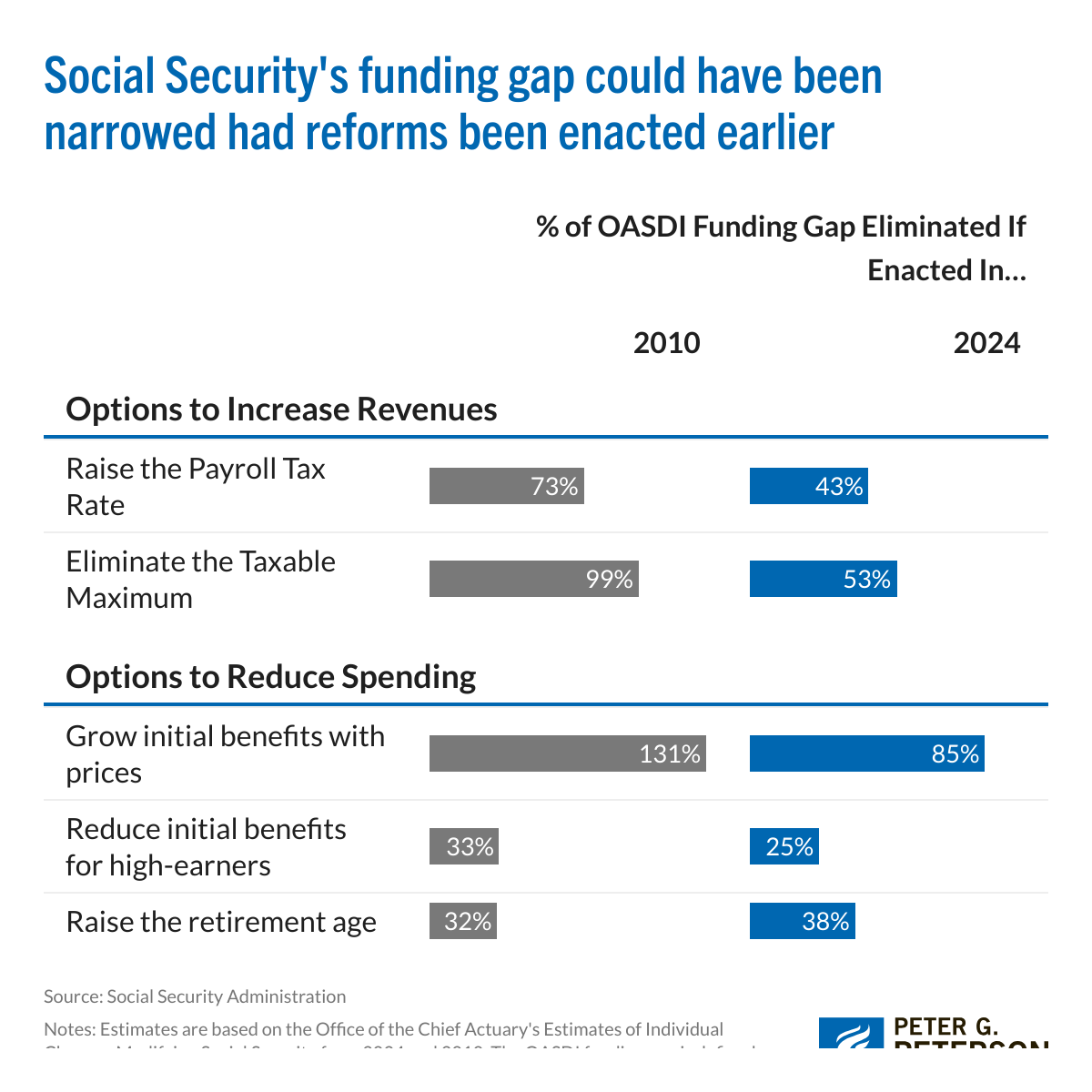How To Save Social Security — Pay More Taxes? Cut Benefits?
These proposals to save Social Security may require big changes, but a survey shows Americans want politicians to act. Are you willing to pay more taxes?


Finding ways to save Social Security is at the top of many Americans' minds, and for good reason. The program, which provides a safety net for over 70 million Americans, is facing a financial shortfall. If nothing is done by 2035, it could run out of money in its trust fund. That would force a 17% reduction in Social Security benefit payments.
There are many reasons that Social Security is in trouble, but changing demographics is the primary one. The chart below demonstrates that America's aging population means fewer young workers are paying into the system per retiree, with the trend gaining steam over the next two decades.
Another factor exacerbating the shortfall is the recent adoption of the Social Security Fairness Act (SSFA). This program will increase Social Security checks for 3.2 million workers who receive public pensions. It is projected to hasten that shortfall by six months if Congress does nothing to shore up Social Security’s coffers.

Sign up for Kiplinger’s Free E-Newsletters
Profit and prosper with the best of expert advice on investing, taxes, retirement, personal finance and more - straight to your e-mail.
Profit and prosper with the best of expert advice - straight to your e-mail.

That bleak outlook for Social Security has prompted lawmakers, think tanks and non-profits to weigh in on how to fix it. While the strategies vary, some agree a mix of raising taxes and boosting revenue can be a way to cover the shortfall and keep Social Security fully afloat.
Save Social Security by reducing costs, boosting revenue
Take the U.S. Government Accountability Office’s ideas, for starters. Issued this past summer, the GAO calls for a combination of improving finances and raising payroll taxes. The way GAO sees it, reducing program costs could be achieved by changing eligibility requirements and benefit amounts. The cost cuts could come by reducing the current and future benefits for everyone collecting Social Security or only for certain groups. The GAO points out that as it stands, Social Security provides benefits to retired workers and, in some instances, their dependents and survivors. Another option is to increase the payroll tax revenue collected by Social Security.
“Acting now to address Social Security’s financial woes would reduce the impacts of changes on beneficiaries," the GAO wrote in a blog post. "Acting now would allow changes to be gradually phased in. It would also give Americans more time to plan for any changes affecting their retirement security."
The GAO isn’t alone in calling for increasing revenue and benefit cuts to fix Social Security. Wendell Primus, an economist and visiting fellow at Brookings Institute, argues that his proposal submitted to the chief actuary by Rep. Steny Hoyer (D-MD) would eliminate Social Security’s deficit and enable the trust fund to grow beyond its 75-year budgeting window.
On the revenue side, Primus — a former Congressional staffer — recommends several measures to reform Social Security. He proposes increasing the taxable wage base (the income an employee earns that is taxed by Social Security) from $176,100 to about $300,000. His plan would also increase the payroll tax from 12.4% to 12.6% and tax benefits for people making $100,000 or more as income tax.
Pushing the full retirement age further out
On the cost-cutting side, Primus proposes increasing the full retirement age for people who have seen “meaningful” increases in life expectancy and can work for more years, extending the average earnings from the highest 35 years of working to 40 years and phasing out the dependent spouse’s benefit. The latter item recognizes that more women are working and thus will collect their own Social Security benefits.
Primus also suggests that all money collected from taxing retirement and disability benefits be placed into the Social Security trust fund. Under current law, these tax proceeds may also line the pockets of other programs, including the Health Insurance Trust Fund for Medicare, Old-Age and Survivors Insurance (OASI) and Disability Insurance (DI) trust fund. It’s worth noting that this component would require a change in Medicare. As it stands, about 85 cents of every Social Security tax dollar a worker pays goes to the Social Security trust fund.
The proposal would also increase certain immigration caps so more people can participate in Social Security and extend coverage. Recognizing the growing health care needs of America's aging society, he recommends adding immigration pathways for direct care workers, such as home health aides.
What's clear is that the problem is only getting worse. The Peter G. Peterson Foundation has done an excellent job of demonstrating the price of delay. Had we taken specific measures in 2010, they would have made much more of a difference than doing so in 2024, with the exception of raising the retirement age.

An end to 401(k)s?
Another idea, which has stirred controversy, is to abolish tax-sheltered savings plans like 401(k)s and IRAs. Proposed by Alicia Munnell, director of the Center for Retirement Research at Boston College, and Andrew Biggs, senior fellow at the American Enterprise Institute (AEI), the two economists argue the reduction in federal income taxes because of IRAs and employer-sponsored plans such as a 401(K) amounted to between $185 and $189 billion in 2020. What’s more, Munnell and Biggs say that these tax-favored retirement savings plans disproportionately benefit the wealthy. If these plans were abolished, those tax revenues could benefit retirees through Social Security instead.
“Revenues saved from repealing the retirement saving tax preferences could be reallocated to address the majority of Social Security’s long-term funding gap, strengthening a program that is crucial for the retirement security of older Americans while bypassing a decades-old debate about raising taxes or reducing Social Security benefits,” the economists wrote in a report.
Do Americans want higher payroll taxes?
Increasing taxes typically raises the ire of Americans. After all, who wants to pay more to the government? Well, it turns out that, at least according to a recent survey by the National Academy of Social Insurance, AARP, the National Institute on Retirement Security, and the U.S. Chamber of Commerce, 85% of Americans are on board.
The survey found that Americans value Social Security across party lines, generations, income and education. They see it as an essential piece of their retirement security. Of those polled, only 4% said it wouldn’t be important to their income when retired. Moreover, an overwhelming majority are willing to pay more taxes if it would save Social Security.
“Eighty-five percent say we should ensure benefits are not reduced, even if it means raising taxes on some or all Americans. The most strongly preferred of all options tested is eliminating the cap on payroll tax contributions for those earning more than $400,000 per year,” wrote the groups in a report on the findings. “Additionally, Americans across all groups, including a majority of Republicans, say they are willing to pay more themselves by gradually increasing the payroll tax rate to strengthen the program’s finances.”
The survey respondents rejected raising the retirement age or switching to a slower cost-of-living adjustment (COLA).
That survey coincides with another one by the National Institute on Retirement Security that examined more than 40 years of public opinion polling on Social Security and found strong support for the program and that confidence in Social Security increases with age. Just like the other survey, it also showed a “solid” majority of Americans believe more money should be spent on Social Security.
Americans want to keep Social Security solvent
Social Security has provided a safety net for retirees since the Great Depression and is something most Americans rely on when they stop collecting a regular paycheck. With the program facing potential insolvency, Americans appear united in doing what it takes to keep their benefits intact.
Related content
Get Kiplinger Today newsletter — free
Profit and prosper with the best of Kiplinger's advice on investing, taxes, retirement, personal finance and much more. Delivered daily. Enter your email in the box and click Sign Me Up.

Donna Fuscaldo is the retirement writer at Kiplinger.com. A writer and editor focused on retirement savings, planning, travel and lifestyle, Donna brings over two decades of experience working with publications including AARP, The Wall Street Journal, Forbes, Investopedia and HerMoney.
-
 Stock Market Today: Trump Retreats, Markets Rejoice
Stock Market Today: Trump Retreats, Markets RejoiceStocks rally, yields soften, the dollar rises, and even beaten-down names enjoy the wages of potential trade peace.
By David Dittman
-
 In Trump’s Economy Should 401(k) Savers 'Set It and Forget It?'
In Trump’s Economy Should 401(k) Savers 'Set It and Forget It?'It’s hard to bury your head in the sand when the markets are volatile. Here’s when it makes sense and when it doesn’t.
By Donna Fuscaldo
-
 I'm 50 and My Home Is Worth $5 Million. Can I Retire Now?
I'm 50 and My Home Is Worth $5 Million. Can I Retire Now?It may be oh-so tempting to cash out your upscale home and leave work for good. But should you? We ask the experts.
By Maurie Backman
-
 Bouncing Back: New Tunes for Millennials Trying to Make It
Bouncing Back: New Tunes for Millennials Trying to Make ItAdele's mournful melodies kick off this generation's financial playlist, but with the right plan, Millennials can finish strong.
By Alvina Lo
-
 Americans Are Retiring Later: Will This Trend Last?
Americans Are Retiring Later: Will This Trend Last?Given a host of pressures to keep working, Americans are retiring later in life. Will regulatory and economic forces encourage you to work longer?
By Christy Bieber
-
 Retiring Without a Partner? How Singles Can Maximize Their Savings
Retiring Without a Partner? How Singles Can Maximize Their SavingsRetirement can be expensive, especially when you do it alone, surveys show. But there are ways to maximize your retirement savings even when facing your second act without a partner.
By Kathryn Pomroy
-
 When Should You Hand Over the Keys — to Your Investments?
When Should You Hand Over the Keys — to Your Investments?The secret to retirement planning? "The best time to hand over the keys is before you’ve realized you need to hand over the keys."
By Maurie Backman
-
 Financial Steps After a Loved One's Alzheimer's Diagnosis
Financial Steps After a Loved One's Alzheimer's DiagnosisIt's important to move fast on legal safeguards, estate planning and more while your loved one still has the capacity to make decisions.
By Thomas C. West, CLU®, ChFC®, AIF®
-
 Two Don'ts and Four Dos During Trump's Trade War
Two Don'ts and Four Dos During Trump's Trade WarThe financial rules have changed now that tariffs have disrupted the markets and created economic uncertainty. What can you do? (And what shouldn't you do?)
By Maggie Kulyk, CRPC®, CSRIC™
-
 I'm Single, With No Kids: Why Do I Need an Estate Plan?
I'm Single, With No Kids: Why Do I Need an Estate Plan?Unless you have a plan in place, guess who might be making all the decisions about your prized possessions, or even your health care: a court.
By Cynthia Pruemm, Investment Adviser Representative